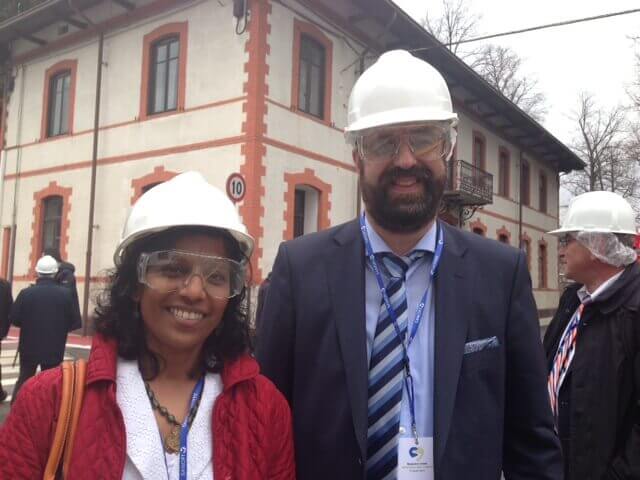Nick TaylorGHTC
Nick Taylor is a senior program assistant at GHTC, where he supports GHTS communications and member engagement activities.
This post was originally featured on path.org on January 27, 2013 and was written by PATH’s Drug Development program. The post is the first in a three-part series. To see future posts in this series, check out path.org.
In December, PATH hosted a Transformative Innovations event in Palo Alto, CA with a panel discussion on ways that public and private sectors can work together to save lives. In three installments, we’ll bring you excerpts of the discussion from our panelists Ponni Subbiah and Anurag Mairal, program leaders of PATH’s Drug Development and Technology Solutions programs, respectively, and Joel Segre, an independent strategy consultant focused on product development and distribution challenges in global health. In our first post, Ponni shares her insights into what makes a partnership successful and reflects on the potential for innovation coming from nontraditional sources.
Q: One of the shifting paradigms of the future is that innovation will be multidirectional and come from anywhere in the world. What impacts do you see this having on solving global health challenges?
PS: It’s quite exciting because it makes our work truly global, not a pushed-down approach to solving global health problems. We’re transitioning from a world where interventions were done to and for countries to a world where innovation happens with countries. Every sector is realizing that you’re missing opportunities by not tapping into local talent. Even though many of our end users lack access to education, their insights, experiences, and knowledge are invaluable to creating a successful end product. The playing field is becoming more even, and partnerships are now happening at the local level.
The younger generation, especially, is much more global and informed in outlook than previous generations, and they’re all about innovation and creativity. The question is, how do we capitalize on that energy and harness it to accomplish global health goals?
Traditionally, especially in the private sector, many local affiliate leaders of international companies were from high-income countries. This is changing with the recognition that developing a talent pipeline at the local level is critical for long-term success within a region or country. Similarly, one of PATH’s goals is to identify leaders on the ground to build a stronger presence in countries. We need strong leaders who are well connected and influential so we can build strong and fruitful relationships with governments and civil-society organizations.

Q: PATH has pioneered the idea that innovation is not just about technology but about the way in which you engage with partners, the business models you deploy, and the way you think about creating markets. What lessons have you learned about how to do this effectively, how to make sure that partnerships result in real impact, rather than more talk and transaction costs?
PS: One of the most critical lessons we’ve learned is that for a partnership to be successful, we have to do the due diligence at the beginning when we’re selecting partners. We need to make sure that the organization we partner with has not only the technical capabilities and areas of expertise needed for the project’s success but also institutional support for the nonprofit aims of the project, especially from senior leadership. It’s important to have those senior leaders on board to be champions for the humanitarian side of an endeavor and to help us drive the project forward.
Once a partner is selected, sitting down from the get-go and having a clear discussion about what each organization hopes to get from the project, what the incentives are, deliverables, etc. is key. These kinds of big-picture discussions, aside from the day-to-day communications that take place, should occur at set intervals, at least every six months, because these variables may change over the course of the project. If the goals of a project change, it will require some course correction to get back on track.
Another critical element of a successful partnership is building trust and transparency. Though we’re all very connected technologically speaking, I find that it’s still important to have face-to-face meetings. Connecting in person and getting to know someone’s personality and work style changes the way we work together, usually for the better. I think it fosters more open interactions and makes people more willing to be flexible and cooperative. In this field especially, when our partners are all over the globe, we have to be cognizant of creating enough opportunities for face-to-face meetings. We try to provide time and support to make sure team members get this opportunity to connect.
What goes hand in hand with building trust and transparency is the ability to have tough discussions. Teams that actually go through some tough discussions and overcome them are the great teams; teams that don’t challenge each other and avoid putting issues on the table never get to that great team level. Each partner brings a different strength and area of expertise to the partnership, and accordingly, each partner is under different institutional demands and pressures. We have to make choices about the battles we pick and where and how we can compromise to move projects forward, given that everyone is committed to a high-quality end result.
As a nonprofit, some of the most important qualities we can bring to the table are expertise in global health, flexibility, and patience. We have to be accustomed to change. With the start and end of each phase of a project, new partners may come aboard and others may become less involved in day-to-day activities. Each project team has to do the same thing—understand where each partner is coming from, identify the critical areas that need further discussion, and then work together to problem solve.
For more Innovation. Transformation. Inspiration., stay tuned to the Drug Development blog for the next two installment with Dr. Anurag Mairal and Joel Segre, and follow them on Twitter and Facebook.
More information